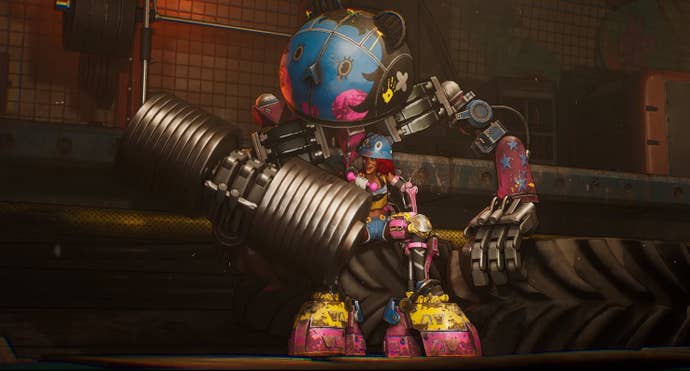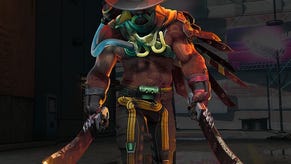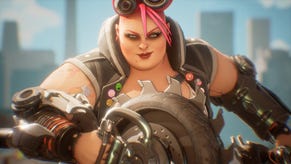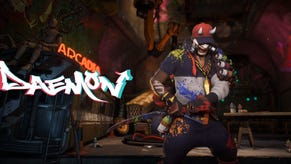Bleeding Edge Review: On the Edge of Glory
Ninja Theory's hero brawler has good ideas, but not enough to keep me hooked.
This article first appeared on USgamer, a partner publication of VG247. Some content, such as this article, has been migrated to VG247 for posterity after USgamer's closure - but it has not been edited or further vetted by the VG247 team.
Bleeding Edge is trying to compete in a genre full of demanding time-sinks and forever games. It's the latest game from Ninja Theory, the studio behind the underrated DmC: Devil May Cry and the narrative-focused Hellblade: Senua's Sacrifice. Now Ninja Theory is tackling the likes of Overwatch and Smite with Bleeding Edge. A squarely multiplayer-focused hero brawler, framed with teams, objectives, and roles, Bleeding Edge still manages to break free from its mold by incorporating some of developer Ninja Theory's requisite action game design. It's fun, it's fast, and thankfully low commitment.
Bleeding Edge is also slim and familiar. After being ushered through a quick tutorial, it feels like the onus is on me to keep playing, rather than Bleeding Edge giving me reasons to keep coming back. Within hours, I felt like I had seen everything Bleeding Edge has to offer. And while it's certainly interesting, it doesn't have the right hooks to compel me to stick with it.
Set in a universe where outlaws and outcasts duke it out in futuristic battle sports, opposing teams of four clash for victory across a handful of maps, either vying for control points or the recovery and deposit of power cells. Each player can pick one of several fighters, divided up into three general roles: damage, tank, and support.
If this is starting to sound a bit like Overwatch, that's because it both is and isn't. Bleeding Edge encourages the same mix of team composition and balance as other role-centric team games, even going as far as to pop up a notification when my squad didn't have a healer in the field. The tutorial makes a point of gradually escalating the size of each fight until it's in a full-blown four-on-four deathmatch, emphasizing the importance of target selection, paying attention to abilities being used, and coordinating with teammates.
But Bleeding Edge is also an action game, arguably even closer to a 3D arena fighting game; most combatants have a dash and parry available, combos can be executed by melee fighters, and spacing and meter management are just as important as hitting the right enemy. To put a finer point, ranged characters in Bleeding Edge use auto-lock-on targeting. This isn't a hero brawler about clicking the right pixel as a sniper, but reading an opponent's movements and finding a way to turn the tables.
It's in that moment-to-moment combat where Bleeding Edge shines brightest. Ninja Theory's track record is clearly felt in the roster, as fighters like the masked swordsman Daemon and beefy tank Makutu are a blast to chain combos with. Different attacks can segue into different chains with varying results. On Makutu, I could vary up my hits to go for an uppercut, launching my opponent into the air, or briefly pause, potentially catching out a parry attempt before initiating my E. Honda-style robotic palm slap.
Even the ranged fighters feel rewarding to play. In most games I drifted toward Gizmo, a ranged damage-dealer who's all about locking down the battlefield with turrets and a hail of minigun fire. Playing Gizmo right felt like playing a zoning-based character in any fighting game, as I had to maintain set distances and gradually layer on pressure, while always being careful of getting cornered or out-maneuvered.

Alongside basic abilities for each character that emphasize their personal styles, like Gizmo's turrets or motorcycle-tank Buttercup's hook attack, each fighter has their pick of two different ultimates. While these offer some cool variations, it quickly became clear which were viable and which were more interesting on paper. As much as I liked Zero Cool's 1UP ultimate, which would revive an ally if they died while under its effect, I found a steady boost of other boons from his alternate ultimate to be more universally useful.
Each character has their own style that feeds into the larger team dynamic. A Zero Cool player can "pocket" one person in particular, providing them with a constant stream of healing from the backlines; whereas Miko players have to get into the fray and do some damage to keep their team topped off. Bleeding Edge ends up accommodating playstyles fairly well in this way, offering capable characters who can get the job done in all the roles.
It isn't the most technically demanding hero brawler around, and depending on the character, there might be a few different possible combos or just one general flowchart. But with different compositions and just enough variety in the melee chains, Bleeding Edge has a good flow that doesn't take hours of dissecting optimal combos in the lab to get into. The pace of the game can oscillate wildly between frantic fights and long moments, either waiting to respawn or jetting to the next locale, but once combat starts, it's easy to forget the lulls.
The variety of characters to choose feels a little low compared to other hero games, though. Bleeding Edge offers 11 fighters at launch, with at least one more on the way, the dolphin-in-a-tank Mekko. Each of these characters range from interesting to looking like they walked right out of a Borderlands DLC, for all the good and bad that entails. As bizarre as the bird-legged Cass or Kulev, a snake possessing a dead body, are, I didn't feel compelled to dive into the history of each character, tucked away in the menus somewhere. Its stylized, in-your-face presentation can get a little grating at times, and really, the fighting is the most memorable aspect of each fighter.
That lack of attachment extends to the map pool as well. Only a handful of venues for carnage are available at launch, and it doesn't take long for them to start cycling over. Each one is rarely memorable outside its unique mechanic, which is often some sort of hazard with a frustrating ability to kill the inattentive. In some cases, these hazards are enjoyable: one night, my group all mocked an enemy for getting steamrolled by a train, before we all simultaneously got splattered for standing on the parallel tracks. It was beautiful, chaotic hubris in action, with just enough ragdoll to make it hilarious. But most maps aren't memorable, and the objective types seem more like incentives for team-fighting rather than offering some sort of strategic alternative over simply bashing the other team for the win.

Despite enjoying the combat and having some good laughs, it felt like I had seen all of Bleeding Edge in the first night of playing it. The only long-term progression in Bleeding Edge, at the moment, is the Mods system. As I gained levels for playing each fighter, I got drops of different Mod chips that can be slotted into my loadout. These boons, at least at the early levels, seem fairly mild—either flat boosts to a stat like Health, or an ability-based reward, like lowering an ultimate cooldown for successful hits with a basic ability. Whether these could eventually become game-defining or breaking has yet to be seen, but they're also not impactful enough to keep me chasing them.
Because Bleeding Edge is on both Xbox One and PC, it also has some strange quirks when it comes to controls. When I first played it last year, the raw combat felt decent on a controller but certain actions, like targeting abilities and specific enemies, felt finicky. At home on a mouse and keyboard, now the targeting feels great but dashes and other reactive moments can get awkward. Either control scheme ultimately works, but it still feels just a hair off in either direction. Given the choice, I think the controller is likely the more comfortable option.
Bleeding Edge sits in a strange spot when it comes to recommending it. In its current state, it feels more in line with free-to-play offerings, and spending $30 on the hope of more to come seems a little optimistic. It's also part of Game Pass on both PC and Xbox One, and that wrinkle suddenly makes Bleeding Edge a different proposition, one with less return-on-investment expectations attached.
It's hard to fault this action-hero brawler for trying something different. It may succeed in the moment-to-moment play, but a lack of standout style, slim initial offering, and no roadmap for long-term progression combine to make a game that's great for a few game nights, but is struggling to hold my attention for much longer. I'm interested to see if Bleeding Edge can foster a community and stay afloat in the sea of multiplayer games that all demand time and attention. It's the equivalent of a found penny in a pocket for Xbox Game Pass owners, but it's far from an Overwatch killer.
ConclusionBleeding Edge has some really good ideas, but not enough content or progression to back them up. It's a solid pick for a few game nights with your pals if you all have Game Pass, but it still needs some time to develop into a true competitor.

















